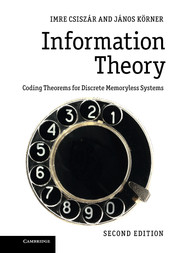Book contents
- Frontmatter
- Contents
- Preface to the first edition
- Preface to the second edition
- Basic notation and conventions
- Introduction
- Part I Information measures in simple coding problems
- Part II Two-terminal systems
- Part III Multi-terminal systems
- 13 Separate coding of correlated sources
- 14 Multiple-access channels
- 15 Entropy and image size characterization
- 16 Source and channel networks
- 17 Information-theoretic security
- References
- Name index
- Index of symbols and abbreviations
- Subject index
14 - Multiple-access channels
Published online by Cambridge University Press: 05 August 2012
- Frontmatter
- Contents
- Preface to the first edition
- Preface to the second edition
- Basic notation and conventions
- Introduction
- Part I Information measures in simple coding problems
- Part II Two-terminal systems
- Part III Multi-terminal systems
- 13 Separate coding of correlated sources
- 14 Multiple-access channels
- 15 Entropy and image size characterization
- 16 Source and channel networks
- 17 Information-theoretic security
- References
- Name index
- Index of symbols and abbreviations
- Subject index
Summary
In Chapter 13 we formulated a fairly general model of noiseless communication networks. The absence of noise means that the coders located at the vertices of the network have direct access to the results of coding operations performed at immediately preceding vertices. By dropping this assumption, we now extend the model to cover communication in a noisy environment. We shall suppose that codewords produced at certain vertices are components of a vector input of a noisy channel, and it is the corresponding channel output that can be observed at some other vertex of the network.
The mathematical problems solved in this chapter will relate to the noisy version of the simplest multi-terminal network, the fork. In order to avoid clumsy notation, we give the formal definitions only for the case of two inputs.
Given finite sets X, Y, Z, consider channels with input set X × Y and output set Z. A multiple-access code (MA code) for such channels is a triple of mappings f : M1 → X, g : M2 → Y, φ : Z → M1 × M2, where M1 and M2 are arbitrary finite sets. The mappings f and g are called encoders, with message sets M1 resp. M2, while φ is the decoder. A MA code is also a code in the usual sense, with encoder (f, g) : M1 × M2 → X × Y and decoder φ.
- Type
- Chapter
- Information
- Information TheoryCoding Theorems for Discrete Memoryless Systems, pp. 272 - 303Publisher: Cambridge University PressPrint publication year: 2011
- 8
- Cited by



